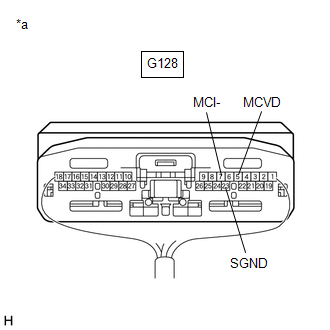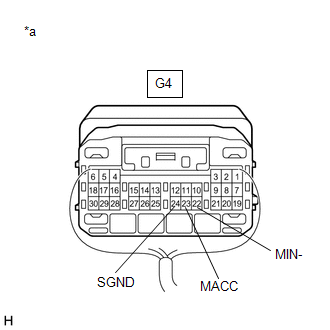Lexus ES: Microphone Circuit
DESCRIPTION
- The radio receiver assembly and telephone microphone assembly are connected to each other using the microphone connection detection signal lines.
- Using this circuit, the radio receiver assembly sends power to the telephone microphone assembly, and the telephone microphone assembly sends microphone signals to the radio receiver assembly.*1
-
Using this circuit, the DCM (telematics transceiver) sends power to the telephone microphone assembly, and the telephone microphone assembly sends microphone signals to the radio receiver assembly via the DCM (telematics transceiver).*2
- *1: w/o Manual (SOS) Switch
- *2: w/ Manual (SOS) Switch
WIRING DIAGRAM
w/ Manual (SOS) Switch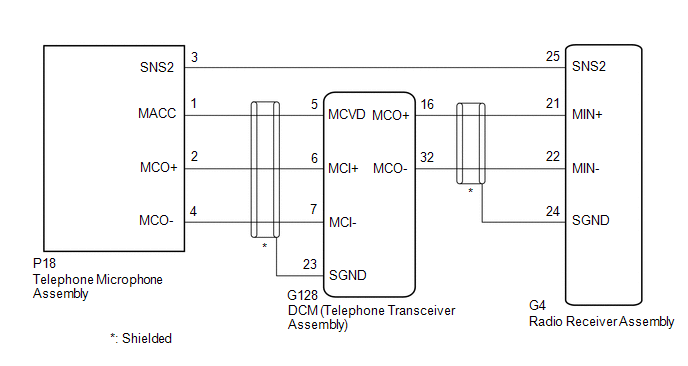 w/o Manual (SOS) Switch
w/o Manual (SOS) Switch 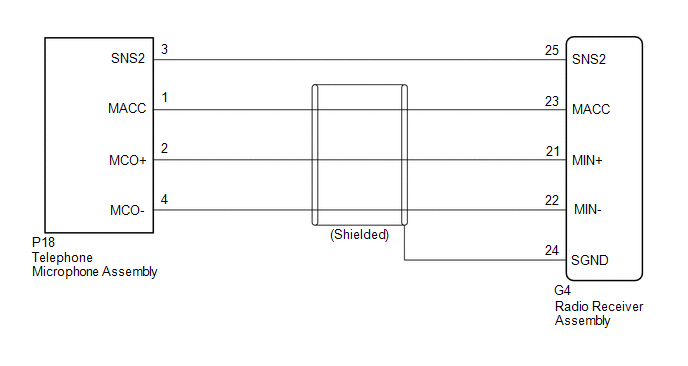
CAUTION / NOTICE / HINT
NOTICE:
-
Depending on the parts that are replaced during vehicle inspection or maintenance, performing initialization, registration or calibration may be needed. Refer to Precaution for Audio and Visual System.
Click here
.gif)
.gif)
-
When replacing the radio receiver assembly, always replace it with a new one.
If a radio receiver assembly which was installed to another vehicle is used, the following may occur:
- A communication malfunction DTC may be stored.
- The radio receiver assembly may not operate normally.
-
Before replacing the DCM (telematics transceiver), refer to Registration.
Click here
.gif)
.gif)
PROCEDURE
| 1. | CHECK MICROPHONE (OPERATION CHECK) |
| (a) Enter the "Microphone Check" screen. Refer to Check Microphone (Input to radio receiver assembly) in Operation Check. Click here |
|
(b) When voice is input into the microphone, check that the microphone input level meter changes according to the input voice.
OK:
Check result is normal.
| OK | .gif) | PROCEED TO NEXT SUSPECTED AREA SHOWN IN PROBLEM SYMPTOMS TABLE |
|
| 2. | CHECK MODEL |
(a) Choose the model to be inspected.
| Result | Proceed to |
|---|---|
| w/ Manual (SOS) Switch | A |
| w/o Manual (SOS) Switch | B |
| B | .gif) | GO TO STEP 9 |
|
| 3. | CHECK HARNESS AND CONNECTOR (RADIO RECEIVER ASSEMBLY - TELEPHONE MICROPHONE ASSEMBLY) |
(a) Disconnect the G4 radio receiver assembly connector.
(b) Disconnect the P18 telephone microphone assembly connector.
(c) Measure the resistance according to the value(s) in the table below.
Standard Resistance:
| Tester Connection | Condition | Specified Condition |
|---|---|---|
| G4-25 (SNS2) - P18-3 (SNS2) | Always | Below 1 Ω |
| G4-25 (SNS2) or P18-3 (SNS2) - Body ground | Always | 10 kΩ or higher |
| NG | .gif) | REPAIR OR REPLACE HARNESS OR CONNECTOR |
|
| 4. | CHECK HARNESS AND CONNECTOR (RADIO RECEIVER ASSEMBLY - DCM (TELEMATICS TRANSCEIVER)) |
(a) Disconnect the G4 radio receiver assembly connector.
(b) Disconnect the G128 DCM (telematics transceiver) connector.
(c) Measure the resistance according to the value(s) in the table below.
Standard Resistance:
| Tester Connection | Condition | Specified Condition |
|---|---|---|
| G4-21 (MIN+) - G128-16 (MCO+) | Always | Below 1 Ω |
| G4-22 (MIN-) - G128-32 (MCO-) | Always | Below 1 Ω |
| G4-21 (MIN+) or G128-16 (MCO+) - Body ground | Always | 10 kΩ or higher |
| G4-22 (MIN-) or G128-32 (MCO-) - Body ground | Always | 10 kΩ or higher |
| G4-24 (SGND) - Body ground | Always | 10 kΩ or higher |
| NG | .gif) | REPAIR OR REPLACE HARNESS OR CONNECTOR |
|
| 5. | CHECK HARNESS AND CONNECTOR (DCM (TELEMATICS TRANSCEIVER) - TELEPHONE MICROPHONE ASSEMBLY) |
(a) Disconnect the G128 DCM (telematics transceiver) connector.
(b) Disconnect the P18 telephone microphone assembly connector.
(c) Measure the resistance according to the value(s) in the table below.
Standard Resistance:
| Tester Connection | Condition | Specified Condition |
|---|---|---|
| G128-5 (MCVD) - P18-1 (MACC) | Always | Below 1 Ω |
| G128-6 (MCI+) - P18-2 (MCO+) | Always | Below 1 Ω |
| G128-7 (MCI-) - P18-4 (MCO-) | Always | Below 1 Ω |
| G128-5 (MCVD) or P18-1 (MACC) - Body ground | Always | 10 kΩ or higher |
| G128-6 (MCI+) or P18-2 (MCO+) - Body ground | Always | 10 kΩ or higher |
| G128-7 (MCI-) or P18-4 (MCO-) - Body ground | Always | 10 kΩ or higher |
| G128-23 (SGND) - Body ground | Always | 10 kΩ or higher |
| NG | .gif) | REPAIR OR REPLACE HARNESS OR CONNECTOR |
|
| 6. | CHECK DCM (TELEMATICS TRANSCEIVER) |
| (a) Remove the DCM (telematics transceiver) with the connector(s) still connected. |
|
(b) Measure the voltage according to the value(s) in the table below.
Standard Voltage:
| Tester Connection | Condition | Specified Condition |
|---|---|---|
| G128-5 (MCVD) - Body ground | Engine switch on (ACC) | 4 to 6 V |
(c) Measure the resistance according to the value(s) in the table below.
Standard Resistance:
| Tester Connection | Condition | Specified Condition |
|---|---|---|
| G128-23 (SGND) - Body ground | Always | Below 1 Ω |
| G128-7 (MCI-) - Body ground | Always | Below 1 Ω |
| NG | .gif) | REPLACE DCM (TELEMATICS TRANSCEIVER) |
|
| 7. | CHECK TELEPHONE MICROPHONE ASSEMBLY (OUTPUT TO DCM (TELEMATICS TRANSCEIVER)) |
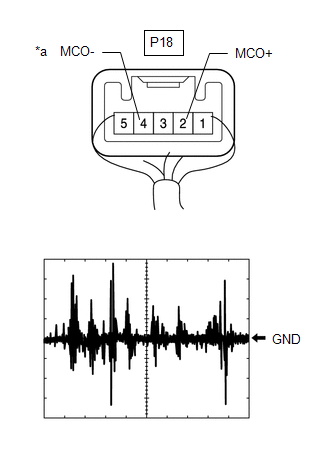
| *a | Component with harness connected (Telephone Microphone Assembly) |
(a) Check the output waveform.
(1) Remove the telephone microphone assembly with the connector(s) still connected.
Click here .gif)
.gif)
(2) Connect an oscilloscope to terminal P18-2 (MCO+) and P18-4 (MCO-).
(3) Turn the engine switch on (ACC).
(4) Sound is input to the telephone microphone assembly when the user is closer than 125 mm from the telephone microphone assembly sound holes in the roof headlining holder cover.
(5) Check the signal waveform according to the condition(s) in the table below.
| Item | Condition |
|---|---|
| Measurement terminal | P18-2 (MCO+) - P18-4 (MCO-) |
| Tool setting | 50 mV/DIV., 500 ms/DIV. |
| Vehicle condition |
|
OK:
The waveform is similar to that shown in the illustration.
HINT:
The oscilloscope waveform shown in the illustration is an example for reference only.
| NG | .gif) | REPLACE TELEPHONE MICROPHONE ASSEMBLY |
|
| 8. | CHECK DCM (TELEMATICS TRANSCEIVER) (OUTPUT TO RADIO RECEIVER ASSEMBLY) |
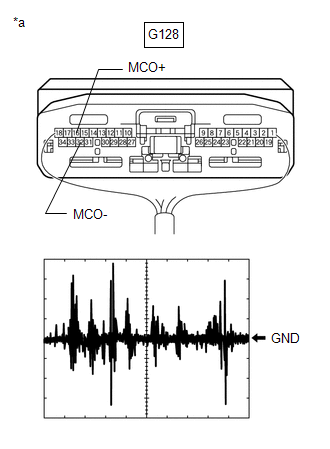
| *a | Component with harness connected (DCM (Telematics Transceiver)) |
(a) Check the output waveform.
(1) Remove the DCM (telematics transceiver) with the connector(s) still connected.
Click here .gif)
.gif)
(2) Connect an oscilloscope to terminal G128-16 (MCO+) and G128-32 (MCO-).
(3) Turn the engine switch on (ACC).
(4) Sound is input to the telephone microphone assembly when the user is closer than 125 mm from the telephone microphone assembly sound holes in the roof headlining holder cover.
(5) Check the signal waveform according to the condition(s) in the table below.
| Item | Condition |
|---|---|
| Measurement terminal | G128-16 (MCO+) - G128-32 (MCO-) |
| Tool setting | 50 mV/DIV., 500 ms/DIV. |
| Vehicle condition |
|
OK:
The waveform is similar to that shown in the illustration.
HINT:
The oscilloscope waveform shown in the illustration is an example for reference only.
| OK | .gif) | REPLACE RADIO RECEIVER ASSEMBLY |
| NG | .gif) | REPLACE DCM (TELEMATICS TRANSCEIVER) |
| 9. | CHECK HARNESS AND CONNECTOR (RADIO RECEIVER ASSEMBLY - TELEPHONE MICROPHONE ASSEMBLY) |
(a) Disconnect the G4 radio receiver assembly connector.
(b) Disconnect the P18 telephone microphone assembly connector.
(c) Measure the resistance according to the value(s) in the table below.
Standard Resistance:
| Tester Connection | Condition | Specified Condition |
|---|---|---|
| G4-25 (SNS2) - P18-3 (SNS2) | Always | Below 1 Ω |
| G4-23 (MACC) - P18-1 (MACC) | Always | Below 1 Ω |
| G4-21 (MIN+) - P18-2 (MCO+) | Always | Below 1 Ω |
| G4-22 (MIN-) - P18-4 (MCO-) | Always | Below 1 Ω |
| G4-25 (SNS2) or P18-3 (SNS2) - Body ground | Always | 10 kΩ or higher |
| G4-23 (MACC) or P18-1 (MACC) - Body ground | Always | 10 kΩ or higher |
| G4-21 (MIN+) or P18-2 (MCO+) - Body ground | Always | 10 kΩ or higher |
| G4-22 (MIN-) or P18-4 (MCO-) - Body ground | Always | 10 kΩ or higher |
| G4-24 (SGND) - Body ground | Always | 10 kΩ or higher |
| NG | .gif) | REPAIR OR REPLACE HARNESS OR CONNECTOR |
|
| 10. | CHECK RADIO RECEIVER ASSEMBLY |
| (a) Remove the radio receiver assembly with the connector(s) still connected. |
|
(b) Measure the voltage according to the value(s) in the table below.
Standard Voltage:
| Tester Connection | Condition | Specified Condition |
|---|---|---|
| G4-23 (MACC) - Body ground | Engine switch on (ACC) | 4 to 6 V |
(c) Measure the resistance according to the value(s) in the table below.
Standard Resistance:
| Tester Connection | Condition | Specified Condition |
|---|---|---|
| G4-22 (MIN-) - Body ground | Always | Below 1 Ω |
| G4-24 (SGND) - Body ground | Always | Below 1 Ω |
| NG | .gif) | REPLACE RADIO RECEIVER ASSEMBLY |
|
| 11. | CHECK TELEPHONE MICROPHONE ASSEMBLY (OUTPUT TO RADIO RECEIVER ASSEMBLY) |
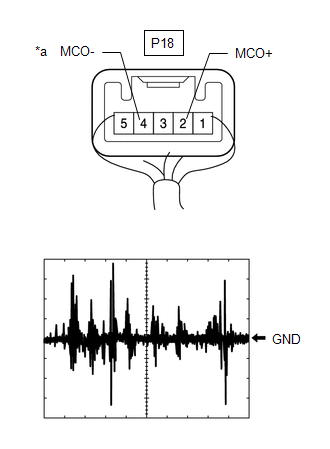
| *a | Component with harness connected (Telephone Microphone Assembly) |
(a) Check the output waveform.
(1) Remove the telephone microphone assembly with the connector(s) still connected.
Click here .gif)
.gif)
(2) Connect an oscilloscope to terminal P18-2 (MCO+) and P18-4 (MCO-).
(3) Turn the engine switch on (ACC).
(4) Sound is input to the telephone microphone assembly when the user is closer than 125 mm from the telephone microphone assembly sound holes in the roof headlining holder cover.
(5) Check the signal waveform according to the condition(s) in the table below.
| Item | Condition |
|---|---|
| Measurement terminal | P18-2 (MCO+) - P18-4 (MCO-) |
| Tool setting | 50 mV/DIV., 500 ms/DIV. |
| Vehicle condition |
|
OK:
The waveform is similar to that shown in the illustration.
HINT:
The oscilloscope waveform shown in the illustration is an example for reference only.
| OK | .gif) | REPLACE RADIO RECEIVER ASSEMBLY |
| NG | .gif) | REPLACE TELEPHONE MICROPHONE ASSEMBLY |

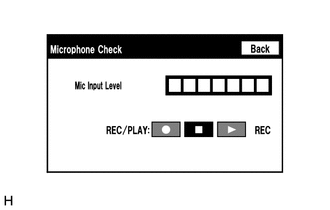
.gif)
